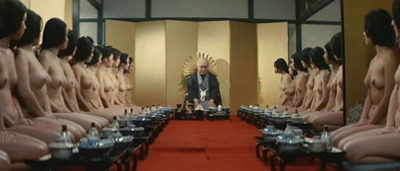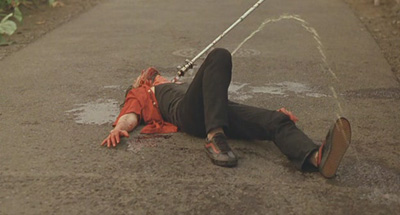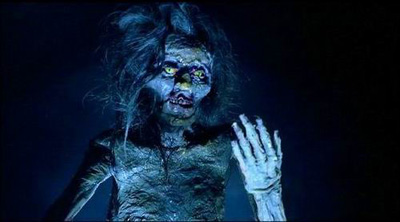 The Japanese title of this film is Porno jidaigeki: Bohachi bushido. Jidaigeki means "period drama," bushido is the Way of the Warrior, the bohachi were sex slavers who had renounced the eight principles of Confucian ethics (sometimes called bohachimono, as in Lone Wolf & Cub: Baby Cart to Hades), and we all know what porno is (although in this case it's decidedly softcore).
The Japanese title of this film is Porno jidaigeki: Bohachi bushido. Jidaigeki means "period drama," bushido is the Way of the Warrior, the bohachi were sex slavers who had renounced the eight principles of Confucian ethics (sometimes called bohachimono, as in Lone Wolf & Cub: Baby Cart to Hades), and we all know what porno is (although in this case it's decidedly softcore).My friend Lonny was raving about this film the other day. I told him I didn't think that highly of it (I had a bootleg long before the recent release from Discotek). He urged me to take another look, and, indeed, it played better this time (although I think I'd prefer to read the original manga by Kazuo Koike upon which it's based).
 The best thing about the movie, in my opinion, is the sword action. Tetsuro Tamba knew how to use a sword, and his stoic, world-weary ronin has a certain vintage Clint Eastwood vibe as he rips and dismembers scores of attackers, later uttering his catchy catch-phrase, "To die is hell, but to live is also hell."
The best thing about the movie, in my opinion, is the sword action. Tetsuro Tamba knew how to use a sword, and his stoic, world-weary ronin has a certain vintage Clint Eastwood vibe as he rips and dismembers scores of attackers, later uttering his catchy catch-phrase, "To die is hell, but to live is also hell."Of course what most guys like about the film is the wall-to-wall naked female flesh, a dimension to which I'm certainly not opposed, but feel could have been handled better. Director Teruo Ishii phoned it in on this one I think, throwing tits 'n ass around haphazardly with little effort at eroticism. Now maybe I'm just see-through faded, super-jaded and out of my mind, but for me Tamba's protracted opium and sex orgy scene was downright soporific, and that ain't right! A scene like that should have me at full attention so to speak, and I blame Ishii for not making that happen. (Check out Norifumi Suzuki's Convent of the Sacred Beast for an example of what I consider the right way to do lubricious love.)
So I put it to you, dear reader: If you've seen this film, leave a comment (you have to have a blogger account, unfortunately). Let me know if you feel Bohachi Bushido is hotter than hot or merely luke warm.



